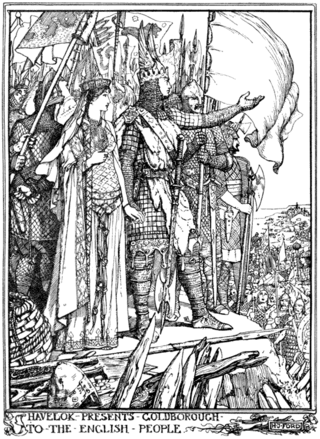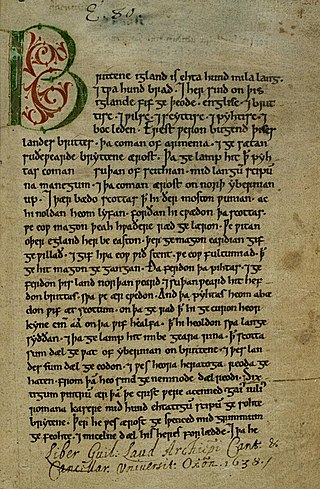Related Research Articles

Ceawlin was a King of Wessex. He may have been the son of Cynric of Wessex and the grandson of Cerdic of Wessex, whom the Anglo-Saxon Chronicle represents as the leader of the first group of Saxons to come to the land which later became Wessex. Ceawlin was active during the last years of the Anglo-Saxon expansion, with little of southern England remaining in the control of the native Britons by the time of his death.

Excalibur is the mythical sword of King Arthur that may possess magical powers or be associated with the rightful sovereignty of Britain. Traditionally, the sword in the stone that is the proof of Arthur's lineage and the sword given to him by a Lady of the Lake are not the same weapon, even as in some versions of the legend both of them share the name of Excalibur. Several similar swords and other weapons also appear within Arthurian texts, as well as in other legends.

The Kingdom of the West Saxons, also known as the Kingdom of Wessex, was an Anglo-Saxon kingdom in the south of Great Britain, from around 519 until Alfred the Great declared himself as King of the Anglo-Saxons in 886.

Edgar Ætheling or Edgar II was the last male member of the royal house of Cerdic of Wessex. He was elected King of England by the Witan in 1066 but never crowned.
Cynric was King of Wessex from 534 to 560. Everything known about him comes from the Anglo-Saxon Chronicle. There, he is stated to have been the son of Cerdic, who is considered the founder of the kingdom of Wessex. However, the Anglian King-list and parts of the West Saxon Genealogical Regnal List, instead says that Cynric was the son of Cerdic's son Creoda. Similarly, the paternal genealogy of Alfred the Great given in Asser's The Life of King Alfred, includes the name Creoda, while the account of the king's maternal ancestry in the same work calls Cynric son of Cerdic.

Cerdic is described in the Anglo-Saxon Chronicle as a leader of the Anglo-Saxon settlement of Britain, being the founder and first king of Wessex, reigning from around 519 to 534 AD. Subsequent kings of Wessex were each claimed by the Chronicle to descend in some manner from Cerdic. His origin, ethnicity, and even his very existence have been extensively disputed. However, though claimed as the founder of Wessex by later West Saxon kings, he would have been known to contemporaries as king of the Gewissae, a folk or tribal group. The first king of the Gewissae to call himself 'King of the West Saxons', was Cædwalla, in a charter of 686.

Hereward the Wake was an Anglo-Saxon nobleman and a leader of local resistance to the Norman Conquest of England. His base when he led the rebellion against the Norman rulers was the Isle of Ely, in eastern England. According to legend, he roamed the Fens, which covers parts of the modern counties of Cambridgeshire, Lincolnshire and Norfolk, and led popular opposition to William the Conqueror.
Ælfthryth was Queen of the English from her marriage to King Edgar in 964 or 965 until Edgar's death in 975. She was a leading figure in the regency during the minority of her son King Æthelred the Unready between 978 and 984.
The House of Wessex, also known as the House of Cerdic, the House of the West Saxons, the House of the Gewisse, the Cerdicings and the West Saxon dynasty, refers to the family, traditionally founded by Cerdic of the Gewisse, that ruled Wessex in Southern England from the early 6th century. The house became dominant in southern England after the accession of King Ecgberht in 802. Alfred the Great saved England from Viking conquest in the late ninth century and his grandson Æthelstan became first king of England in 927. The disastrous reign of Æthelred the Unready ended in Danish conquest in 1014. Æthelred and his son Edmund Ironside attempted to resist the Vikings in 1016, but after their deaths the Danish Cnut the Great and his sons ruled until 1042. The House of Wessex then briefly regained power under Æthelred's son Edward the Confessor, but lost it after the Confessor's reign, with the Norman Conquest in 1066. All kings of England since William II have been descended from the House of Wessex through William the Conqueror's wife Matilda of Flanders, who was a descendant of Alfred the Great through his daughter Ælfthryth. Additionally, kings since Henry II have been descended from English kings from the House of Wessex through Henry I's wife Matilda of Scotland, who was a great-granddaughter of Edmund Ironside.

Havelok the Dane, also known as Havelok or Lay of Havelok the Dane, is a thirteenth-century Middle English romance considered to be part of the Matter of England. The story, however, is also known in two earlier Anglo-Norman versions, one by Geffrei Gaimar and another known as the Lai d'havelok. The name "Havelok" also has many variations in spelling, and can be found as "Haveloc", "Havelock", or "Aybloc".
Geoffrey Gaimar, also written Geffrei or Geoffroy, was an Anglo-Norman chronicler. His contribution to medieval literature and history was as a translator from Old English to Anglo-Norman. His L'Estoire des Engleis, or History of the English People, written about 1136–1140, was a chronicle in eight-syllable rhyming couplets, running to 6,526 lines.
The Gewisse were a tribe or ruling clan of the Anglo-Saxons. Their first location, mentioned in early medieval sources was the upper Thames region, around Dorchester on Thames. However, some scholars suggest that the Gewisse had origins among the ancient Britons at Cair-Caratauc in Wiltshire. According to Saxon folklore, the Gewisse were the founders of the kingdom of Wessex.
Anglo-Norman literature is literature composed in the Anglo-Norman language and developed during the period of 1066–1204, as the Duchy of Normandy and the Kingdom of England were united in the Anglo-Norman realm.
Gilbert Fitz Richard, 2nd feudal baron of Clare in Suffolk, and styled "de Tonbridge", was a powerful Anglo-Norman baron who was granted the Lordship of Cardigan, in Wales c. 1107–1111.

The Brut or Roman de Brut by the poet Wace is a loose and expanded translation in almost 15,000 lines of Norman-French verse of Geoffrey of Monmouth's Latin History of the Kings of Britain. It was formerly known as the Brut d'Engleterre or Roman des Rois d'Angleterre, though Wace's own name for it was the Geste des Bretons, or Deeds of the Britons. Its genre is equivocal, being more than a chronicle but not quite a fully-fledged romance.

Alan Rufus, alternatively Alanus Rufus (Latin), Alan ar Rouz (Breton), Alain le Roux (French) or Alan the Red, 1st Lord of Richmond, was a Breton nobleman, kinsman and companion of William the Conqueror during the Norman Conquest of England. He was the second son of Eozen Penteur by Orguen Kernev. William the Conqueror granted Alan Rufus a significant English fief, later known as the Honour of Richmond, in about 1071.
Creoda is a shadowy figure from early Wessex history whose existence is disputed.

The Anglo-Saxon Chronicle is a collection of annals in Old English, chronicling the history of the Anglo-Saxons.

Pain fitzJohn was an Anglo-Norman nobleman and administrator, one of King Henry I of England's "new men", who owed their positions and wealth to the king.
A number of royal genealogies of the Anglo-Saxon kingdoms, collectively referred to as the Anglo-Saxon royal genealogies, have been preserved in a manuscript tradition based in the 8th to 10th centuries.
References
- ↑ Christopher Harper-Bill; Elisabeth Van Houts (2007). A Companion to the Anglo-Norman World. Boydell & Brewer Ltd. p. 209. ISBN 978-1-84383-341-3.
- 1 2 3 Peter Damian-Grint (1999). The New Historians of the Twelfth-century Renaissance: Inventing Vernacular Authority. Boydell & Brewer. p. 49. ISBN 978-0-85115-760-3.
- 1 2 3 4 5 6 7 Dalton, Paul (2007). "The Date of Geoffrey Gaimar's Estoire des Engleis, the Connections of His Patrons, and the Politics of Stephen's Reign". The Chaucer Review. 42 (1): 23–47. doi:10.1353/cr.2007.0020. S2CID 154451757. Project MUSE 217685.
- ↑ "Emeritus Professor Ian Short". bbk.ac.uk. Retrieved 27 May 2015.
- 1 2 3 Gaimar, Geffrei (2009). Short, Ian (ed.). Geffrei Gaimar: Estoire des Engleis: History of the English. doi:10.1093/actrade/9780199569427.book.1. ISBN 978-0-19-956942-7.[ page needed ]
- 1 2 John Spence (1 April 2013). Reimagining History in Anglo-Norman Prose Chronicles. Boydell & Brewer Ltd. p. 9. ISBN 978-1-903153-45-1.